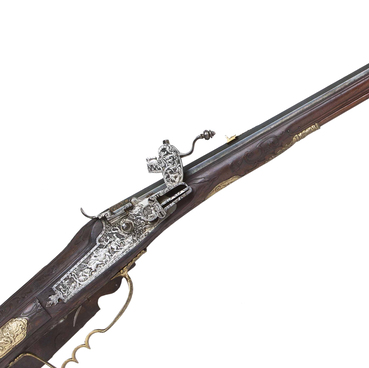The wheellock rifle of the Tschinke type from the Gatchina Palace and Estate Museum is one of the oldest items in its collection of hunting weapons. However, the most important feature of the rifle is an unusual construction of the wheellock. It looks as if it is turned inside out. Almost all its parts including the wheel and the mainspring are mounted on the outside of the lock plate.
This construction allowed the gunsmith to make the stock as thin and light as possible. There are also several elements and peculiarities which were typical for long guns produced in the town of Teschen in Silesia. The rifles were used to hunt small game, mostly birds, that is why manoeuvrability and precision were paramount for them. Such rifles were very popular among hunters and were one of the main exports for Teschen, a historical region in south-eastern Silesia between the rivers of Vistula and Oder.
Local gunmakers kept manufacturing such rifles for the most part of the 17th and 18th centuries practically without any changes in the construction. So the name of the town Teschen gave the name to the rifle — Tschinke. The barrel of the Tschinke is faceted and rifled and has thick walls. Yet its bore is small and the barrel itself is not as heavy as barrels of standard wheellock rifles. All the surface of the barrel is blued and some parts are gilded and decorated with engraved curls. The rifle has a dioptre sight. It is made in the form of a short gilded pipe which encloses a blade with a notch. The front sight is made of iron with partial gilding. The upper side planes of the barrel at the breech end have marks in the form of the letters ‘P’ and ‘K’.
The lock plate is flat and is decorated with an engraved stylised floral pattern. To the right of the wheel the plate is blued and to the left — gilded. The wheel shaft is held in place by a gilded iron bracket with an engraved floral pattern. All the surface of the stock is inlaid with bone and mother of pearl inserts in the form of small circles and stripes, various animals and plants. The cheek piece is decorated with an image of Saint George and the dragon, the right side of the buttstock — with an image of a hare surrounded by mythical creatures, and the bottom side — with an image of the goddess Fortuna on a winged sphere. Near the ramrod channel there is a bone plate decorated with an engraved man’s profile.



